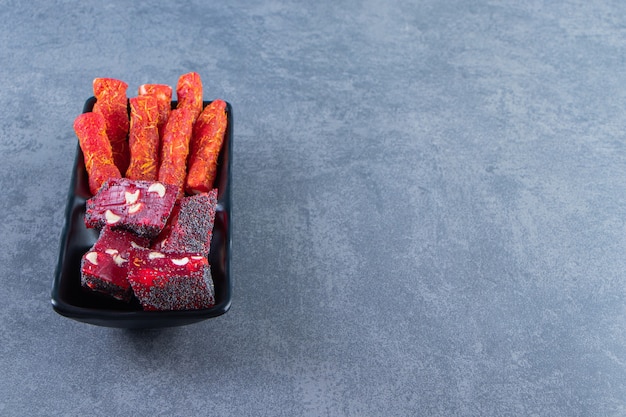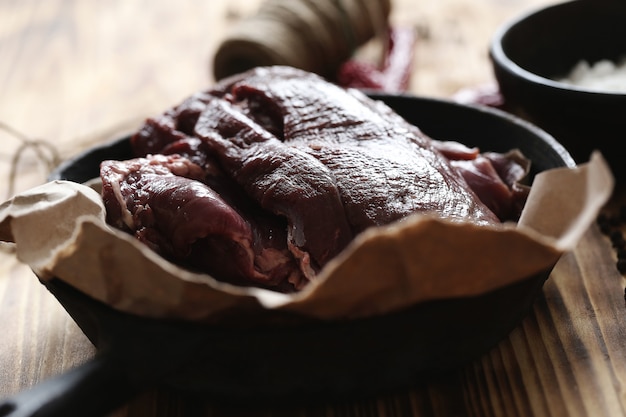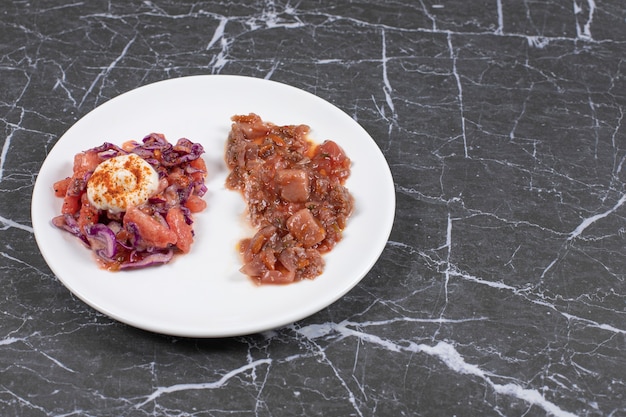You know that satisfying crunch, that burst of savory flavor, that chewy texture? Yeah, that's jerky! And let me tell you, making your own is a game-changer. Not only is it incredibly satisfying to create something delicious from scratch, but it also gives you complete control over the ingredients and the level of spice, sweetness, or smokiness you crave. Trust me, once you've tasted homemade jerky, store-bought just won't cut it.
This is your comprehensive guide to crafting mouthwatering jerky, from choosing the perfect cut of beef to mastering the drying process. I'll share my personal tips and tricks, born from years of experimentation and a whole lot of trial and error (because, let's face it, even the best cooks have their mishaps). Ready to get your hands a little messy? Let's dive in!
(Part 1) Selecting the Right Beef: The Foundation of Flavor

The Cut: Choosing Your Beefy Hero
Jerky starts with the perfect cut of meat. You want lean, flavorful beef that will hold up well during the drying process. Here's a breakdown of some popular choices:
- Top Round: My go-to for jerky! It's consistently tender, lean, and boasts a great flavor profile.
- Sirloin Tip: Another winner, offering a good balance of leanness and flavor.
- flank steak: A bit tougher than the other two, but packs a powerful punch when it comes to flavor. It holds its own during drying, resulting in a chewy, satisfying texture.
If you're unsure about which cut to go with, just head to your local butcher. They're a wealth of knowledge and will be happy to point you in the right direction, even slicing the meat to your desired thickness.
Thickness is Key: Getting the Right Bite
The thickness of your beef matters. You want a piece that's about ?? to ?? inch thick. Too thin, and it'll dry out too quickly, leaving you with a dry, tough piece of jerky. Too thick, and it'll take forever to dry, potentially resulting in uneven drying or a jerky that's still raw in the center.
(Part 2) Preparing the Beef: Setting the Stage for Flavor

Trimming the Fat: Lean and Mean
Before you start marinating, it's important to trim off any excess fat from your beef. This will prevent your jerky from becoming greasy and will ensure a cleaner, more flavorful taste. I like to use a sharp knife and carefully trim away any visible fat, aiming for a lean and mean piece of meat.
Slicing and Dicing: Finding Your Jerky Shape
Now, the fun part – shaping your jerky! You can go for classic strips, which are easy to handle and tend to dry more evenly. Or, if you're feeling adventurous, you can cube your beef into smaller pieces for a unique, bite-sized experience.
Tenderizing the Meat: A Softer Bite
A meat mallet is a jerky maker's best friend. Give your beef a few whacks to break down the fibers, making it more tender and easier to chew. This is especially helpful if you're using a tougher cut like flank steak. Don't have a mallet? No worries, the back of a heavy knife will do the trick.
(Part 3) Marinating for Flavor: The Heart of Your Jerky

The Magic of Marinades: A Symphony of Flavors
Marinades are the secret weapon for turning your jerky from ordinary to extraordinary. They infuse the meat with rich flavor, keep it moist during drying, and add a delightful complexity to the final product.
My Go-To Marinade: A Classic Combo
Over the years, I've experimented with countless marinade combinations, but this one remains my favorite. It's simple, versatile, and delivers a punch of deliciousness:
- Soy Sauce: Adds a salty, savory base.
- Worcestershire Sauce: Brings a complex umami depth.
- Brown Sugar: A touch of sweetness that balances the savory notes.
- Garlic Powder: Adds a fragrant, pungent aroma.
- Onion Powder: Introduces a mellow, savory note.
- Black Pepper: A touch of heat and a classic flavor pairing.
I typically whisk these ingredients together in a bowl, then submerge the beef strips in the marinade for at least 2 hours. For maximum flavor infusion, I'll leave them in the fridge for up to 24 hours, making sure to flip them occasionally to ensure they're evenly marinated.
Unleashing Your Creativity: Experiment with Flavors
Don't be afraid to break the mold and experiment with different flavors. You can add chili powder for a spicy kick, smoked paprika for a smoky depth, or even a touch of honey for a sweet and savory twist. Remember, the world of flavor is your oyster!
(Part 4) Drying the Jerky: The Art of Patience
The Dehydrator: Your Jerky Guru
A food dehydrator is the ultimate tool for creating perfectly dried jerky. It's designed to distribute heat evenly, ensuring consistent drying and a delicious, chewy final product.
Setting the Stage: Ready for Dehydration
Before you start drying, make sure your dehydrator is clean and ready to go. Arrange the marinated beef strips in a single layer on the trays, ensuring they don't overlap. This allows air to circulate freely and prevents uneven drying, resulting in consistently tasty jerky.
The Drying Time: A Dance with Time
Drying time depends on the thickness of your beef and the temperature of your dehydrator. Typically, it takes about 6-8 hours, but you'll know it's done when the jerky is firm, chewy, and no longer sticky. Don't be tempted to rush the process – patience is key!
The Oven Alternative: When You Don't Have a Dehydrator
Don't own a dehydrator? No worries, you can still dry jerky in your oven. Just set it to the lowest setting, usually around 170°F (77°C), and leave the oven door slightly ajar to allow moisture to escape. This method takes a bit longer, but it works well.
(Part 5) Storing Your Jerky: Keeping it Fresh and Delicious
Airtight Containers: Lock in the Flavor
Once your jerky is fully dried, it's time to store it properly to maintain its freshness and texture. Airtight containers or resealable bags are ideal for this purpose.
Refrigeration: The Perfect Preservation
I usually store my jerky in the refrigerator, which keeps it fresh for several weeks. If you want to store it for longer, you can freeze it.
Freezing for Longevity: Keeping It Fresh for Months
To avoid freezer burn, wrap the jerky tightly in plastic wrap or foil before placing it in a freezer-safe bag. This will help to protect it from the elements and keep it tasting delicious for months.
(Part 6) Jerky for Everyone: Variations and Options
Spicy Jerky: Ignite Your Taste Buds
If you're a fan of fiery flavors, add chili powder, cayenne pepper, or a dash of hot sauce to your marinade. Start with a small amount and adjust to your preference. Remember, a little heat can go a long way!
Sweet and Savory Jerky: A Balanced Bite
For a sweet and savory kick, add a teaspoon or two of honey or maple syrup to your marinade. This will create a lovely balance of flavors that will have you coming back for more.
Jerky Beyond Beef: Expanding Your Horizons
While beef jerky is the classic, there's a whole world of jerky possibilities out there. Here are a few other meaty options:
- Chicken Jerky: Lean and flavorful, chicken jerky is a great alternative to beef.
- Turkey Jerky: A healthier option, turkey jerky is just as delicious as beef jerky.
- Salmon Jerky: For a unique and flavorful treat, try making salmon jerky.
- venison jerky: A lean and gamey option for the adventurous, venison jerky is a true taste of the wild.
(Part 7) Jerky for Every Occasion: Beyond the Snack
The Snacking King: Jerky's Versatility
Jerky is a snacking superstar! It's high in protein, low in carbohydrates, and packed with flavor. It's perfect for hiking, camping, or enjoying a quick and satisfying snack at home.
Trail Mix Booster: Adding a Savory Punch
I love adding jerky to my trail mix for a savory and chewy element. It complements the nuts and dried fruits beautifully.
Jerky in the Kitchen: Flavoring Up Your Dishes
You can even use jerky in your cooking! It's a great addition to soups, stews, and stir-fries, adding a burst of flavor and protein.
(Part 8) My Top Jerky-Making Tips: Years of Experience in a Nutshell
1. Patience is a Virtue: The Art of Slow Drying
Drying jerky takes time. Don't rush the process. Let the jerky dry slowly and evenly for the best results.
2. Embrace Experimentation: Flavor is Your Canvas
Get creative with your marinades! There are endless possibilities when it comes to flavor combinations.
3. Lean is King: Trimming for a Clean Flavor
Trim off any excess fat from your beef before marinating and drying. This will prevent your jerky from becoming greasy and ensure a clean, flavorful taste.
4. The Meat Mallet: Your Tenderizing Tool
A meat mallet will help to break down the fibers in your beef, making it more tender and easier to chew.
5. Storage is Key: Maintaining Freshness
Store your jerky properly to keep it fresh and delicious. Airtight containers and refrigeration are your best friends. Freezing is also a great option for long-term storage.
FAQs: Your Jerky Questions Answered
1. How Long Does Homemade Jerky Last?
If stored properly in the refrigerator, homemade jerky can last for several weeks. If you freeze it, it can last for several months.
2. Can I Make Jerky in a Regular Oven?
Yes, you can make jerky in a regular oven. Just set it to the lowest setting and leave the oven door slightly ajar to allow moisture to escape. It will take longer to dry, but it's a viable option.
3. What if My Jerky is Too Tough?
If your jerky is too tough, it might be because it was overdried. Next time, try drying it for a shorter period. You can also try rehydrating it by soaking it in water for a few hours before eating.
4. How Can I Prevent Jerky From Getting Moldy?
To prevent mold growth, make sure to store your jerky in airtight containers or resealable bags and keep it in the refrigerator or freezer.
5. What Are Some Other Uses for Jerky Besides Snacking?
Jerky can be added to soups, stews, stir-fries, and even salads for a boost of protein and flavor. It's a versatile ingredient that can add a unique dimension to your dishes.
I hope this ultimate guide has inspired you to embark on your own jerky-making journey. It's a fun and rewarding experience, and the end result is a delicious, healthy snack that you can enjoy any time. Happy jerking!
Everyone is watching

Corn on the Cob: The Ultimate Guide to Perfectly Cooked Ears
Healthy MealsAh, corn on the cob. Just the name evokes images of sunny days, barbecues, and that sweet, juicy flavour that ...

Scallops: The Ultimate Guide to Perfect Cooking
Healthy MealsAh, scallops. Those delicate, sweet, and utterly delicious morsels of the sea. They hold a special place in my...

Spaghetti Squash: The Ultimate Guide to Cooking and Serving
Healthy MealsRemember that time you saw spaghetti squash at the supermarket, looking all bumpy and strange, and thought, "W...

Salmon Cooking Times: Perfect Guide for Every Recipe
Healthy MealsLet me tell you, cooking salmon is an art form. It's all about getting that perfect balance: juicy and tender,...

Ham Cooking Time: How Long to Bake, Smoke, or Boil a Delicious Ham
Healthy MealsAh, ham. It's a classic, isn't it? A real crowd-pleaser, especially around holidays. And when done right, it'...
